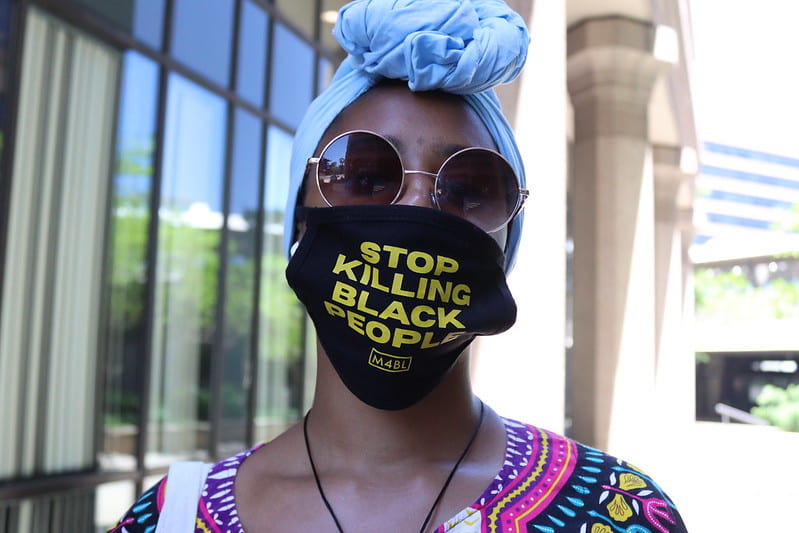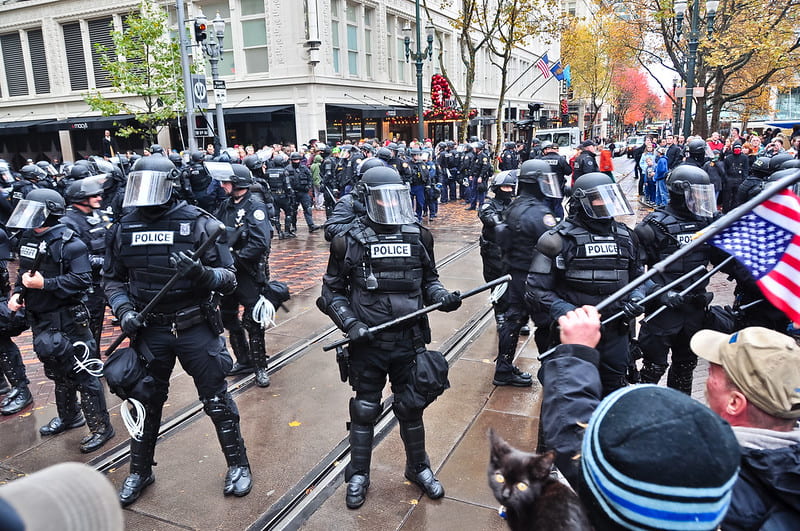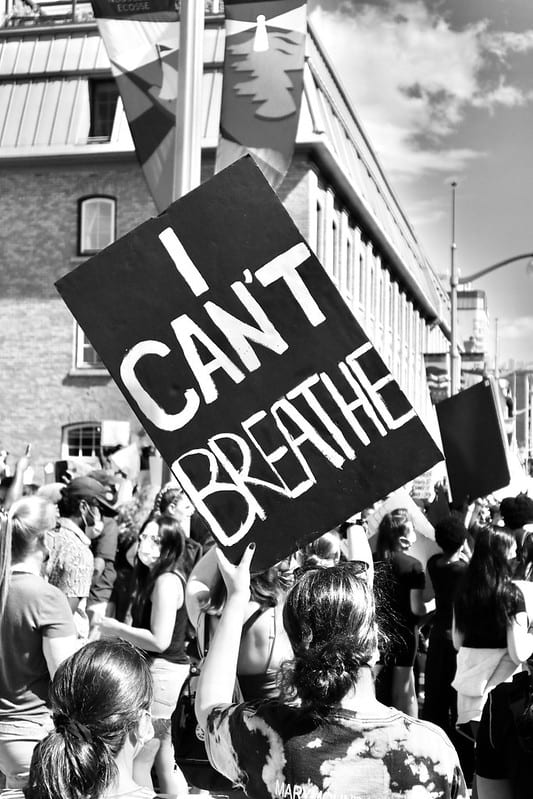
Throughout the summer of 2020, the cries of “Black Lives Matter!” and “I can’t breathe!” echoed across the United States. These cries took the form of protests that occurred in many cities around the country and even around the world. The increase of Black Lives Matter protests has been occurring in the months following the murder of George Floyd by police officers in May of 2020. Frustration over the lack of action by local and national authorities as well as community members themselves, led to some protestors to resort to violent tactics. It is important to keep in mind that while Mr. Floyd’s death was a catalyst that sparked the increase in protests, police brutality and the discrimination of black populations within many United States systems has existed since the times of slavery. These disparities within the system have been left unaddressed for too long, and many agree that peaceful protest will not incite the necessary action and change. However, while some of the protests have resulted in property damage and other violent acts, the majority of the protests have been very peaceful.
In response, President Trump has repeatedly called for a “crackdown” and continues to characterize protestors as violent and dangerous, despite the fact that over 90 percent of the thousands of nationwide protests have been peaceful. He declared New York City, New York, Portland, Oregon and Seattle, Washington, cities that have hosted several Black Lives Matter protests, to be “anarchist cities,” which in turn could make them ineligible for important federal funds during the Covid-19 pandemic. President Trump has also refused to address the very valid concerns of protestors, instead vowing to defend the police as opposed to answering the call to pursue reforms to the policing structure. He has taken an authoritarian approach to the Black Lives Matter protests, sending in federal agents to “take care of the situation” in cities where very large Black Lives Matter protests have been held. His response is in stark contrast to the response of protests held earlier in the summer, protesting state lockdowns and mask ordinances in response to the onset of the Covid-19 pandemic.

In Portland, Oregon, federal agents dressed in camouflage and tactical gear were called in to handle the local Black Lives Matter protests. They were part of ‘rapid deployment teams’ created by the Department of Homeland Security. Such agents were also deployed within Washington, D.C., San Diego, California, Buffalo, New York, and Las Vegas, Nevada. In D.C., federal agents utilized “chemical agents” to disperse a crowd. Also in D.C., military helicopters flew over protestors below roof level, causing panic and leaving protestors to run for cover. Some protestors described experiences of being grabbed off the street by plainclothes policemen and agents, thrown in a van, and being taken to a location where they were held for multiple hours without being told a reason for their apparent arrest. Lawsuits have been opened due to increased injuries experienced by protestors and accusations of the agents engaging in ‘unlawful tactics.’ The deployment of these federal agents into Portland and other cities is an extremely unnecessary show of force. The federal government labeled the protection of government property and the discouragement of unrest as the excuse for the presence of the agents. This excuse angered local authorities, with the governor of Oregon, Gov. Kate Brown, declaring the influx of federal agents a “blatant abuse of power.”
A few weeks before George Floyd’s death, in late April 2020, protestors gathered outside of Michigan’s state capital chanting, “Let us in! Let us in!” The protestors, many of them armed and carrying semiautomatic rifles, forcibly attempted to enter the Michigan capitol building. They were protesting the new state lockdown and restrictions that were put in place by Michigan’s governor in response to an increase of Covid-19 cases within the state. The protestors were tightly packed and very few were wearing masks. Some protestors shouted anti-government slogans and some compared Michigan’s governor, Gretchen Whitmer, to Hitler. One protest sign threatened to hang state officials and read, “Tyrants get the rope.” The horde of protestors was blocked only by state police and a few capitol staff members. Some of the protestors managed to get into the gallery above the main legislative floor and stood menacingly above lawmakers, waving semiautomatic rifles and shouting down at the lawmakers below. It became so bad that the few lawmakers who did own bullet proof vests began wearing them. Other similar protests occurred within Michigan and the sentiment was carried across the country.

President Trump’s response to these increasingly intimidating and violent protests? He encouraged them. In a series of tweets in mid-April, the president called on citizens to “LIBERATE MICHIGAN!”, “LIBERATE MINNESOTA!”, and “LIBERATE VIRGINIA…” At this time, the pressure to reopen the economy was extremely high and President Trump seceded any leadership during the pandemic to the state governors, while criticizing the ones who quickly invoked strict lockdown procedures and mask ordinances. He encouraged protestors and stoked an angry fire among his conservative supporters.
Within the United Nation’s Universal Declaration of Human Rights, several articles protect the right to protest. Article 7 declares equal protection under the law without any discrimination. Article 20 protects the freedom of peaceful assembly. Article 19 protects the freedom of expression. These are declared as universal human rights and the constitution of the United States echoes this important sentiment. Included within the First Amendment is the freedom of protest, or more specifically “the right of the people peaceably to assemble and to petition the Government for a redress of grievances…” Protesting has long been an acceptable way to make grievances known in the United States. So why were President Trump’s responses to these two protests so drastically different?
An argument has been made that the Black Lives Matter protests are so violent that they require a similar level of violence to be contained. The Armed Conflict Location and Event Data Project (ACLED) took information from over 7,750 Black Lives Matter protests and demonstrations across the United States. The organization found fewer than 220 of these protests violent. This means that more than 93% of Black Lives Matter protests have been peaceful. The definition of violence, as determined by ACLED, includes fighting against police, vandalism, property destruction, looting, blocking roads, and burning of items. They also included the toppling and destruction of Confederate and slave owner statues. Despite this evidence, many people still believe the Black Lives Matter protests to be largely violent. A poll resulted in 42% of respondents stating that they believe the majority of Black Lives Matter protestors to be oriented towards violence. ACLED believes that this misconception is perpetuated by biased and disproportionate media coverage of the protests and demonstrations.

Many studies have shown that police and federal agents have disproportionately interfered in the Black Lives Matter protests as opposed to other protests, like the mask ordinance protest in Michigan. President Trump’s actions have showcased a true bias against Black Lives Matter protestors as he actively works to impede upon their right to protest. It can very simply come down to the racism President Trump uses to dictate many of his actions and that his supporters continue to encourage. America was never a great nation to many groups of people and the presidency of Donald Trump has pushed the United States even further from greatness.
